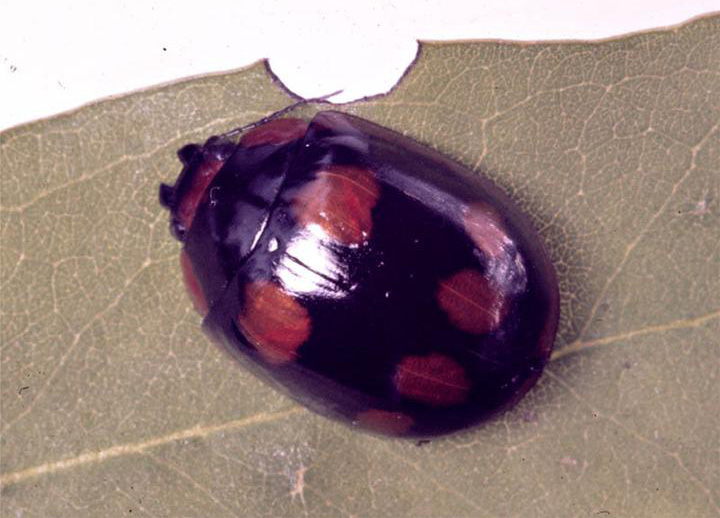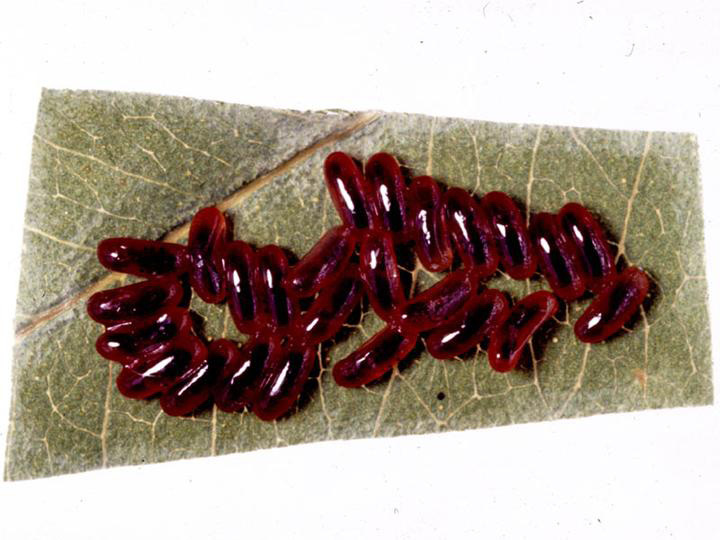PESTS AND DISEASES OF FORESTRY IN NEW ZEALAND
A new paropsine beetle found in New Zealand
Scion is the leading provider of forest-related knowledge in New Zealand
Formerly known as the Forest Research Institute, Scion has been a leader in research relating to forest health for over 50 years. The Rotorua-based Crown Research Institute continues to provide science that will protect all forests from damage caused by insect pests, pathogens and weeds. The information presented below arises from these research activities.
From Forest Health News 233, February 2013.

In August 2012 Paropsisterna beata (Chrysomelidae) was found in Wightman’s Valley, Upper Hutt. It was found on Eucalyptus nitens. Only adults and eggs were found. The identification was made by the Ministry for Primary Industries (MPI) Plant Health & Environment Laboratory in Auckland and confirmed by Chris Reid at the Museum of Australia, Sydney.
Paropsisterna beata is an Australian species and is apparently quite common in south-eastern Australia. The adults and larvae feed on the foliage of Eucalyptus spp. and it has been recorded from E. bridgesiana, E. camaldulensis, E. dunnii, E. grandis, E. moluccana and E. polyanthemos. Its host range is almost certainly greater than this.
There is very limited published information on its biology. In the laboratory its total development period is 5-6 weeks so it is expected that it will have two generations a year in the field. If it behaves like most other paropsines the adults will be long lived and lay eggs over quite a period of time so there will be some overlapping of generations. The adults overwinter, usually under loose bark. Paropsine adults are generally good fliers.
The adults feed on old foliage but usually lay their eggs on young foliage; the larvae feed on young foliage.

As is usually the case it is not known how P. beata got to New Zealand but it would seem likely that it was as overwintering adults in a container.
Only time will tell what effect P. beata will have on eucalypts here but on a positive note it is very likely that the eggs of P. beata will be parasitized by Enoggera nassaui and Neopolycystus insectifurax, two Australian parasitoids that attack Paropsis charybis, another Australian paropsine that has been here since 1916. P. charybdis is the most important defoliator of eucalypts in New Zealand. For further information see Biological control of Paropsis charybdis.
MPI have produced a one page information sheet on the beetle this can be downloaded here. Among other things it tells people what to do if they think they have found P. beata.
John Bain
This information is intended for general interest only. It is not intended to be a substitute for specific specialist advice on any matter and should not be relied on for that purpose. Scion will not be liable for any direct, indirect, incidental, special, consequential or exemplary damages, loss of profits, or any other intangible losses that result from using the information provided on this site.
(Scion is the trading name of the New Zealand Forest Research Institute Limited.)

 Farm Forestry New Zealand
Farm Forestry New Zealand

